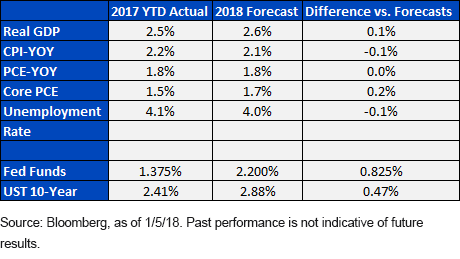U.S. Fixed Income: Will 2018 Be Any Different?


Now that the champagne has gone flat and college football season has come to an end, investors are facing 2018 square in the eye. Sure, based on consensus forecasts, it appears as if there are no great expectations for the new year in terms of the economic outlook, but who can blame anybody, especially after experiencing what seemed to be a virtuous cycle of mediocre growth numbers and surprisingly low inflation on almost a yearly basis? That raises the question: Could 2018 actually be any different?
The below consensus U.S. economic and rate forecasts do not appear to offer any groundbreaking insights. In terms of growth, real GDP is expected to be essentially unchanged this year compared to what transpired through the first three quarters of 2017 (the Q4 real GDP report is slated to come out January 26). While the economists’ projection is little changed, it should be noted that, if the estimate does come to fruition, it would represent a two-year ascending trajectory from the +1.5% pace of 2016 and improvement from the +2.2% growth rate that has been printed since the Great Recession ended in mid-2009. In terms of employment, the jobless rate is not anticipated to show much movement, dropping from 4.1% to 4.0%.
On the inflation side of the equation, the forecast is certainly no bomb cyclone. Indeed, the year-over-year gains for both the Consumer Price Index and the personal consumption expenditures (PCE) price index look eerily similar to last year’s experience. Excluding the volatile food and energy components, the core PCE measure is expected to register a modest uptick of 0.2 percentage points to +1.7%. Putting it all together, it would seem as if inflation is, once again, not yet ready to be a game changer.
U.S. Economic Forecast vs. 2017 YTD Actuals

All right, let’s ask the question: What if the forecasts are wrong, and if so, how could things tilt differently? From a growth and inflation perspective, there is no doubt the surprise in either case would be for stronger-than-expected readings. If one were to utilize the New York Fed’s Nowcast forecast, Q4 2017 real GDP is projected to come in at +4.0%. It would mark the first time since the 2004–05 period that growth had exceeded 3.0% for three consecutive quarters. Starting out 2018, Nowcast looks for a 3.4% increase in Q1. Interestingly, this type of performance would break a string in which three out of the last four years, Q1 real GDP has visibly disappointed, and perhaps more importantly, put growth for the entire calendar year in a hole to start things off. That leads us to inflation. It seems difficult to imagine that the “inflation bogeyman” will rear its ugly head this year, but given the bond markets’ complacency on this front, any signs of a renewed upward path could prove to be an issue.
Conclusion
So what does it all mean for interest rates, and could 2018 be any different? From a Federal Reserve (Fed) perspective, the policy makers seem to be on track for at least two rate hikes this year, with the potential for three (the FOMC’s December 2017 projection is for three increases), and of course a continuation of the balance sheet normalization process. The more interesting outcome could be for the U.S. Treasury (UST) 10-Year yield. While our base case for a 2.25% to 2.75% range may not seem too exciting, if growth and inflation data were to surprise to the upside, the UST 10-Year yield could be spending more time toward the upper portion of this band. This would represent a visible change from the 2017 experience, when the yield finished only 3 basis points (bps) below the 2016 year-end reading.
Unless otherwise noted, data source is Bloomberg as of January 5, 2018.


